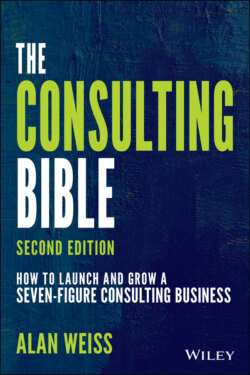Читать книгу The Consulting Bible - Alan Weiss - Страница 12
The Gospel
ОглавлениеAll clients know what they want. Few know what they need. That difference is your value‐added.
You can see in Figure 1.2 that your value distance is the difference between what the client states is wanted and what you demonstrate is really needed. That's often accomplished merely by asking this complex question: “Why?”
“We want a leadership training program. Can you design one?”
“Yes, but why do you want such a program?”
“Once people get to district manager, our attrition rate goes way up. They are obviously not prepared for the job.”
“That's one possibility. But the increased travel, management pressure, and dealing with administrative requirements might also be causing tremendous stress and unhappiness, right?”
“Well, yes.”
“Then shouldn't we investigate, ascertain the real reasons, and formulate appropriate responses? Training might not accomplish enough.”
FIGURE 1.2 Value Distance
One of the primary flaws of unsuccessful consultants is that they accept client wants as the real need. The need is almost always beyond and above the stated want. If you simply satisfy the client want (no value distance) or advance it slightly (small value distance), your value is not very great.
However, if you demonstrate to your client that the real underpinnings of the issue need to be addressed, you can broaden the project, best delight the client, and, not surprisingly, charge the highest fee.
This concept of need is critical to consulting success. No one, but no one, cares about your mission, or vision, or values, all of which are now monotonously pontificated on countless consultant web sites:
“We believe in the highest level of integrity and ethics.”
Oh, too bad, I was looking for an unethical consultant.
Your own beliefs and value and firm history are irrelevant and hugely boring to buyers. What fascinates them are their own history, values, and beliefs. The more you cater to what's in it for them, the more successful you'll be in holding their attention. And always bear in mind that buyers have two sets of needs: professional and personal.
Thus:
Never settle for what a buyer claims is wanted (even if the word “need” is employed). Probe to find out what conditions prompted the initiative to scratch that particular itch. Ask “Why?” to raise the lever of the decision.
Always seek professional needs (e.g., greater market share) and personal needs (e.g., I want to stop acting as a referee between teams and between team and client).
No matter what type of consulting you're undertaking, these facts are immutable. However, the various forms do have some distinctions.
